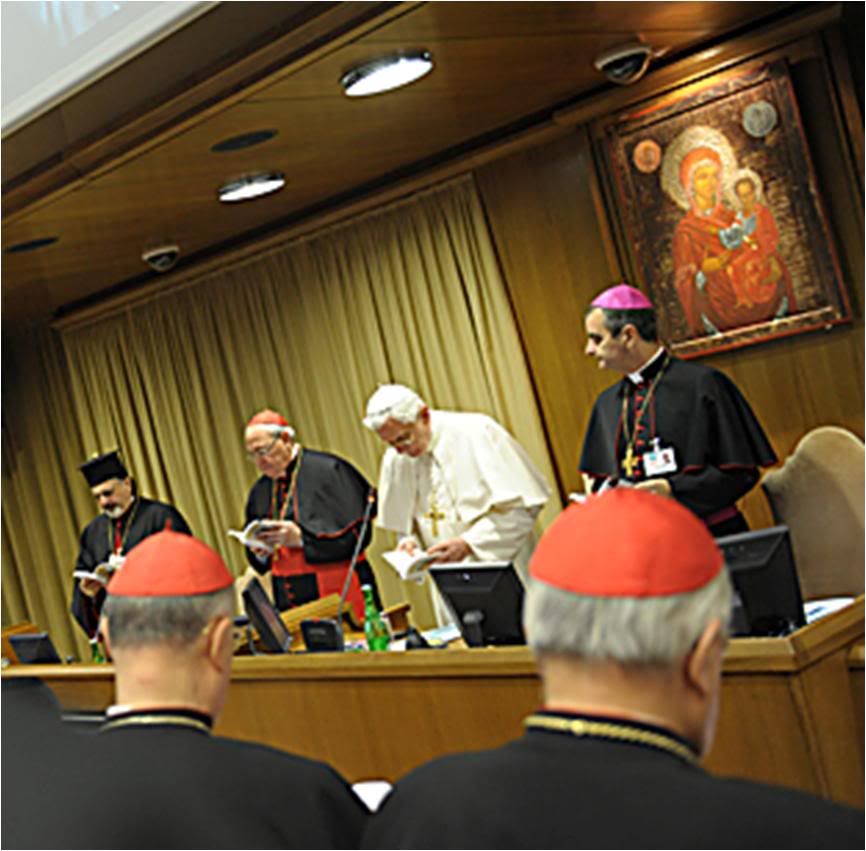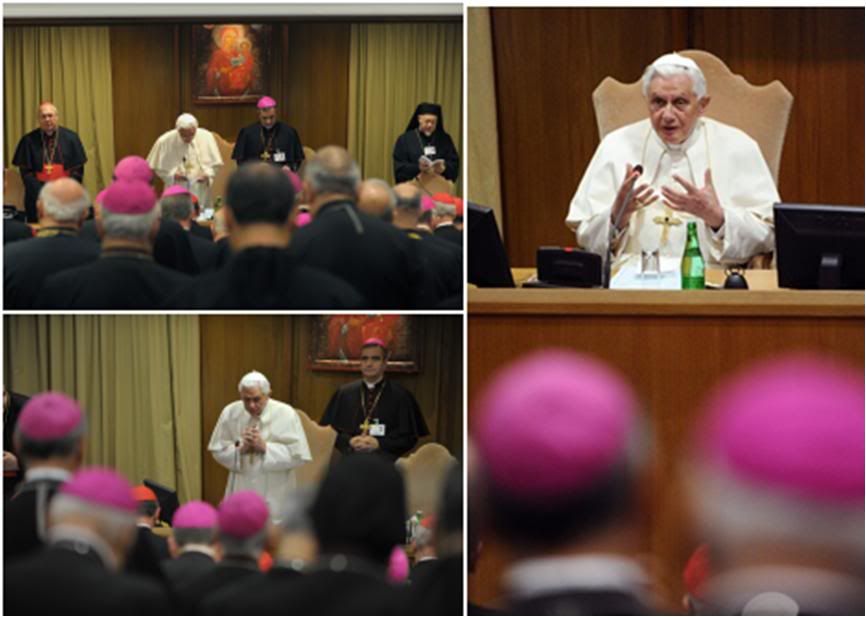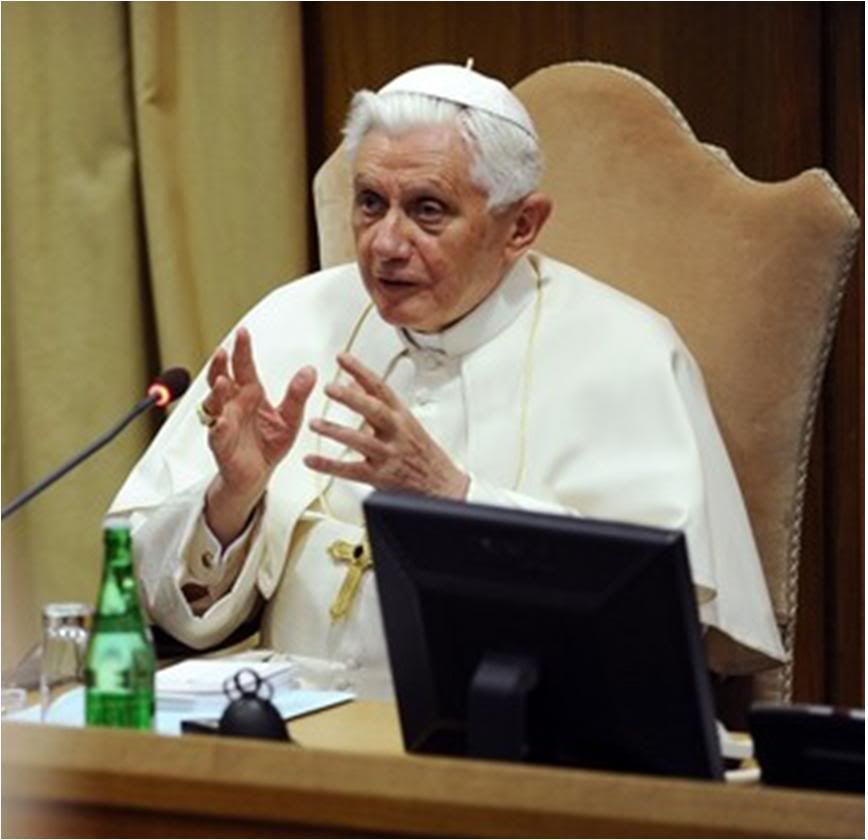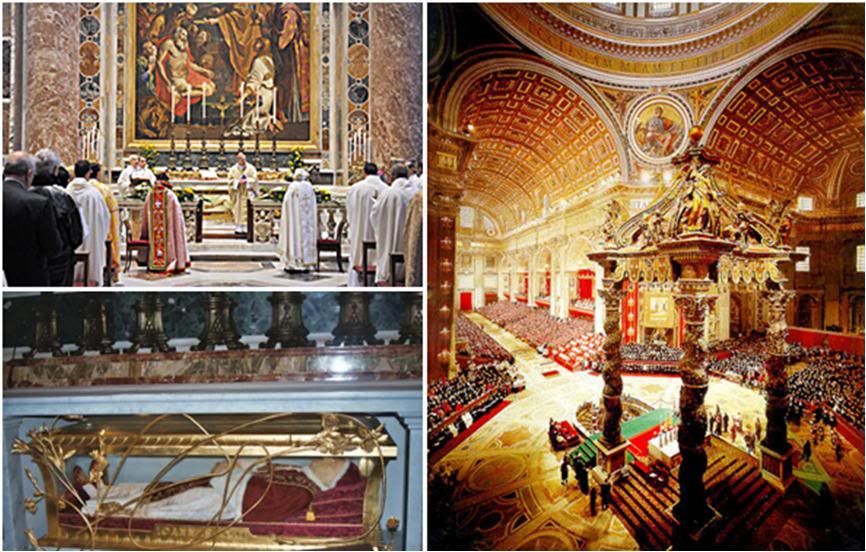| | | OFFLINE | | Post: 21.217
Post: 3.853 | Registrato il: 28/08/2005
Registrato il: 20/01/2009 | Administratore | Utente Master | |
|

 Benedict XVI goes from peak to peak, when he talks to us, even when he improvises, as he did today in his 'reflection' - another model homily - on the liturgical reading that he led as the Special Synodal Assembly for the Middle East started its working sessions this morning. It is hard to imagine any other living person who can improvise a reflection like the following. Like Benedict's entire thought process, it goes from peak to peak of wisdom and insight. It is difficult to describe the intellectual thrill, the spiritual upliftment, the awe of simple faith - and the great privilege - that I experience when I translate a text like this....
BENEDICT XVI:
Benedict XVI goes from peak to peak, when he talks to us, even when he improvises, as he did today in his 'reflection' - another model homily - on the liturgical reading that he led as the Special Synodal Assembly for the Middle East started its working sessions this morning. It is hard to imagine any other living person who can improvise a reflection like the following. Like Benedict's entire thought process, it goes from peak to peak of wisdom and insight. It is difficult to describe the intellectual thrill, the spiritual upliftment, the awe of simple faith - and the great privilege - that I experience when I translate a text like this....
BENEDICT XVI:
A reflection on the readings
for the Third Hour of the
Liturgical Office today
Translated from

Oct. 10, 2010

Dear brothers and sisters,
On October 11, 1962, 38 years ago, Pope John XXIII inaugurated the Second Vatican Council. At the time, the Feast of the Divine Motherhood of Mary was celebrated on that day. With this gesture, with this date, Pope John entrusted the entire Council into the maternal hands and the maternal heart of Our Lady.
We too are starting on Oct. 11, we too would like to entrust the Synod, with all its problems, with all its challenges, with all its hopes, to the maternal heart of Our Lady, of the Mother of God.
Pius XI, in 1930, had introduced this feast, 1600 years after the Council of Ephesus, which had legitimized the title of Theotokos, Dei Genitrix - Mother of God - for Mary. In these words 'Mother of God', the Council of Ephesus synthesized the entire doctrine on Christ and on Mary, the entire doctrine of redemption.
Thus it is worthwhile reflecting a bit, at this time, on what concerned the Council of Ephesus, on what this day tells us.
In fact, Theotokos is a daring title. A woman as the Mother of God. One might well ask, How is it possible? God is eternal, he is the Creator. We are creatures, we are within time. How can a human being be Mother of God, of the Eternal, when we are all within time, we are all creatures?
We can well understand why there was fierce opposition from some to the term. The Nestorians said, one can speak of Christothokos, but not of Theotokos. Theos, God, is beyond and above the events of history.
But the Council of Ephesus decided to approve it, and in that way, it brought to light God's adventure, the greatness of what he did for us. God did not keep to himself: he emerged to radically unite himself to a man, Jesus, the man Jesus who is God, and whenever we speak of him, we speak of God.
The man who was born of Mary was not just a man who had something to do with God. In him, God was born on earth. God had emrged from himself, so to speak. But we can also say the opposite: that God has drawn us to himself so that we are no longer outside God, but we are within the intimacy of God himself.
Aristotelian philosophy, as we know, tells us that between God and man, there can only be a non-reciprocal relationship. Man refers himself to God, but God, the Eternal, is self-sufficient, he does not change - he cannot have one relationship today and another one tomorrow. He is in himself, without any relationships ad extra.
This is all very logical, but it can make us despair: So God has no relationship with me? But with the Incarnation, with the Theotokos, this changed radically, because God has now drawn us to himself, God in himself is a relationship, and he makes us participate in his interior relationship.
We are in him as he is Father, Son and Holy Spirit. We are within his 'being as a relationship'. We are in a relationship with him ourselves, and he has truly created a relationship with us.
God wished to be born of a woman to be himself always: this was the great event. Thus we can understand the profundity of Papa Giovanni's action, when he entrusted the Conciliar, synodal sessions to the central mystery, the Mother of God who was drawn by God into himself, and thus, all of us with her.
The Council started with the image of the Theotokos. At its conclusion, Paul VI conferred on our lady the title of Mater Ecclesiae, Mother of the Church. These two icons, which began and ended the Council, are intrinsically linked and are ultimately just one.
Because Christ was not born as an individual like all the rest. He was born to make himself into a body - as John says in Chapter 12 of his Gospel, to draw everyone to him and in him. He was born, as Paul says in the Letters to the Colossians and to the Ephesians, to recapitulate the whole world, as the firstborn of many brothers. He was born to unite the cosmos in himself, so that he would be the Head of a great Body.
The act of recapitulation began when Christ was born, it was the moment of calling, of the construction of his Body, the Holy Church. The Mother of the Theos, Mother of God, is the Mother of the Church, because she is the Mother of him who came to reunite us all in his resurrected Body.
St. Luke makes us understand this in the parallelism between the first chapter of his Gospel and thr first chapter of the Acts of the Apostles, which repeat the same mystery on two levels.
In the first chapter of Luke's Gospel, the Holy Spirit comes to Mary so that she would give birth and give us the Son of God. In the first chapter of the Acts, Mary is at the center of the disciples of Jesus praying together, invoking the cloud of the Holy Spirit. Thus from the believing Church, with Mary at the center, is born the Church as the Body of Christ.
This double birth is the unique birth of Christus totus, Christ who embraces the world and all of us.
Birth in Bethlehem, birth at the Cenacle. Birth of the Baby Jesus, birth of the Body of Christ, of the Church. They are two events, or just one.
But in between came the Cross and the Resurrection. and the way to the totality of Christ, to his risen Body, to the universalization of his being in the oneness of the Church, is only through the Cross.
Thus, keeping in mind that the harvest can only come from a grain fallen to earth, only from the Lord pierced on the Cross can come the universality of his disciples united in his Body that died and was resurrected.
With this link between the Theotokos and Mater Ecclesiae, we turn to the last book of Sacred Scripture, the Apocalypse, where in Chapter 12, this very synthesis appears.
The woman clothed with the sun, with twelve stars around her head and the moon beneath her feet, gives birth. She does so with a cry of pain, she gives birth in great pain. Here, the Marian mystery is the mystery of Bethlehem extended to the cosmic mystery.
Christ is always born anew in every generation, and thus assumes and takes all of mankind into himself. This cosmic birth was realized in his cry from the Cross, in the pain of his Passion. The blood of martyrs belongs to this cry from the Cross.
So, we can look back at the second Psalm for this Ora Media, Psalm 81, where we see a part of this process. God is one of many gods, or those who were still considered gods by Israel. In this psalm, in a great concentration, in a prophetic vision, we see the depotentiation (disempowering) of gods. Those who appeared as gods are not gods - they lose divine character and they fall to earth. 'Dii estis et moriemini sicut nomine' (Gods though you be... like any mortal you shall die)(cfr Ps 81(82),6-7): This is their disempowering, the fall of the gods.
This process which takes place during Israel's long journey of faith, and which is summarized here in one vision, is a true process in the story of religion: the fall of the gods.
Thus the transformation of the world, knowledge of the true God, the depotentiation of the powers that dominate the earth, is a painful process.
In the history of the people of Israel, we see how this self-liberation from polytheism, this acknowledgment that "Only he is God', takes place amid so much suffering, starting with Abraham's journey, exile, the Maccabees, until Christ.
This process of depotentiation that the Apocalypse describes in Chapter 12 continues in history. It speaks of the fall of angels, who are not angels, they are not divinities on earth.
And this truly takes place, precisely at the time of the nascent Church, where we see how the blood of martyrs disempowered all divinities, starting with the divine emperor. It is the blood of martyrs, the cry of Mother Church, which brings them down and thus transforms the world.
This fall is not only from knowing that they are not God - it is the process of the world's transformation, at the price of blood, at the price of the sufferings of those who bear witness to Christ.
If we look closely, we can see that this process is never completed. I takes place in the various periods of history in ways that are always new - even today, at this moment, when Christ, the only Son of God, should be born into the world again with the fall of other gods, in the suffering, in the martyrdom of his witnesses.
Let us think of the great powers in our world today - the anonymous capitalists (financiers) who enslave man, who are no longer human but an anonymous power that men must serve, by whom men are tortured and even massacred. They constitute a destructive power that threatens the world.
Then there is the power of terroristic ideologies. Purportedly in the name of God, violence is committed. But they are not of God - they are false divinities who must be unmasked.
Then drugs, this power that, like a voracious beast, has its hands on all parts of the world, and destroys. It is a divinity but a false one that must be brought down.
Even the lifestyle that is propagated by public opinion, i.e., - today, this is how it is: marriage no longer matters, chastity is no longer a virtue, and the like.
These ideologies that dominate, which impose themselves by force, are divinities. In the suffering of saints, in the suffering of believers, of the Mother Church of whom we are part, these divinities must fall.
We must realize what the Letters to the Colossians and the Ephesians says: let the dominations and the powers fall and become subject to the one Lord Jesus Christ.
Chapter 12 of the Apocalypse speaks of the battle we are waging - in this depotentiating of divinities, in the fall of false gods, who fall because they are not divinities but powers that destroy the world - with a mysterious image for which, I think, there are many different and beautiful interpretations.
It says that the dragon sets a large river in the way of the woman who is fleeing, in order to sweep her away. It seems inevitable that the woman would drown in this river. But the good earth soaks up the water which can no longer harm.
I think that the waters can be easliy interpreted - they are the currents that dominate everyone and wish to sweep out the faith of the Church, which apparently is to have no place in the face of these currents which impose themselves as the only rationality, as the only way of life.
And the earth that absorbs these waters is the faith of the simple folk, who do not let themselves be carried away by these rivers, and keep the Mother as well as the Son.
That is why the first Psalm of the Ora Media [Tierce, Third Hour of the Office of the Day] says that the faith of the simple folk is the true wisdom (cfr Ps 118[119],130) ["The revelation of your words sheds light, gives understanding to the simple"].
This true wisdom of simple faith, which does not allow itself to be devoured by the waters, is the strength of the Church. Which brings us back to the Marian mystery.
There is another statement from Psalm 81, "movebuntur omnia fundamenta terrae" [All the world's foundations shake](81,5). We see that today, with climate change, how the foundations of the earth are threatened, and threatened by our own behavior. The exterior foundations are shaky because the interior foundations are - the moral and religious foundations, the faith of those who follow the right way of living.
We know that faith is the foundation, and that without a doubt, the foundations of the earth cannot shake if faith, true wisdom, remains firm.
Then the psalm says, "Arise, o God, judge the earth" (v 8). So we, too, say to the Lord: "Arise now, take the world into your hands, protect your Church, protect mankind, protect the earth".
Let us trust anew in the Mother of God, in Mary to whom we pray: "You, the great believer, who opened the earth to heaven, help us, open the doors today so that truth may triumph - the will of God which is the true good and the true salvation of the world". Amen.


10/12/10
P.S. And look at the reduction to which a secular outlet like the New York Times reported the above reflection (the reporter calling it 'remarks', to begin with)... And then they even give her a byline, for a four-sentence report!....
At Synod with Mideast bishops,
Pope condemns terror ideologies
By ELISABETTA POVOLEDO in Rome

October 11, 2010
Pope Benedict XVI opened a two-week synod of Catholic bishops from the Middle East on Monday by condemning terrorist ideologies carried out in “God’s name.” In off-the-cuff remarks to the bishops and other religious leaders who convened for the synod, the Pope said that these acts of violence have “nothing to do with God and instead everything to do with false gods that must be exposed.” The aim of the synod, which ends Oct. 24, is to discuss problems faced by Christians living in the Middle East, where the Catholic Church’s members have been dwindling because of war, and economic and social conflict. It also hopes to foster better communication between the Catholic churches there and Rome, as well as improve interreligious dialogue with Muslims and Jews.
 A further homage to Blessed John XXIII, whose liturgical feast is the opening date of Vatican-II.
A Mass to honor John XXIII
Translated from the 10/12/10 issue of
A further homage to Blessed John XXIII, whose liturgical feast is the opening date of Vatican-II.
A Mass to honor John XXIII
Translated from the 10/12/10 issue of

 Left panel, the Mass on Monday morning and Blessed John's remains; on the right, a stunning picture of St. Peter's interior during Vatican-II.
Left panel, the Mass on Monday morning and Blessed John's remains; on the right, a stunning picture of St. Peter's interior during Vatican-II.
On the liturgical feast of Blessed John XXIII, which is on the anniversary of the opening of the Second Vatican Council, Mass was said at the altar of St. Jerome, beneath which his remains are on display in St. Peter's Basilica.
Presiding at the concelebrated Mass was Cardinal Walter Kasper, with representatives from the Synodal fathers now meeting on the Middle East situation: Syrian Patriarch Younan, one of the presidents-delegate of the assembly; Syro-Malankar Major Archbishop Thottunkal of India; Archbishop Vasil, secretary of the Congregation for Oriental Churches; Archbishop Farhat, a former Nuncio to Turkey, a post held by the future John XXIII during the years just before and during World War II; Bishop Salachas, apostolic exarch for the Byzantine-rite Catholics living in Greece; Bishop Bercea of the Byzantine-rite Catholics of Romania; Bishop Puthur of the Syro-Malabar Catholics of India; and the Franciscan Custodian of the Holy Land, Fr. Pizzaballa.
Also present were many priests from Bergamo, the late Pope's hometown, and from Rome.
It was a homage from tthe Eastern Churches to Papa Roncalli,whose intercession they invoked "for Benedict XVI and all the Synodal participants, so that in obedience to teh Holy spirit, they may show the oriental Churches new paths to peace and unity that will keep them firmly on the way that is Christ".
I have been unable to find a photo online of John XXIII opening Vatican-II.
[Modificato da TERESA BENEDETTA 12/10/2010 16:02] |